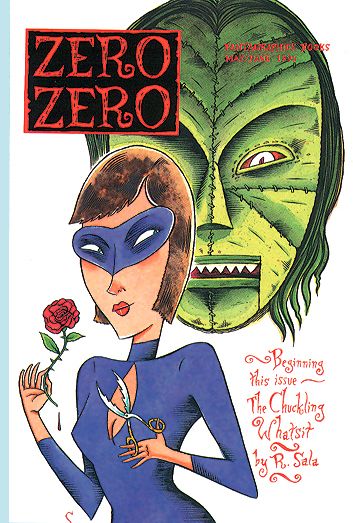Everyone knows about Zap, Arcade, Raw, Weirdo, Mome, Paper Rad and Kramer's Ergot. Even lesser lights like Taboo, Twisted Sisters, the SPX anthology and even (gulp) Heavy Metal have all gotten their due at one time or another. But then there are those anthologies that, for whatever reason, never seem to resonate with readers despite containing a host of high quality contributions. Below the jump are six anthologies I don't think have fully gotten their due. Be sure to let me know what your picks are in the comments section.
1. Zero Zero. Fantagraphics had anthologies coming out of the ying-yang in the late 1990s -- Pictopia, Snake Eyes, Centrifugal Bumble-Puppy (whoops, sorry, that was 1987) -- but for my money the best anthology the publisher produced in that decade was Zero Zero, a dark, edgy anthology that stoked pre-millennial fears (hence the title) while featuring some truly stellar comics by top-notch creators. To wit: The Search for Smilin' Ed by Kim Deitch, Crumple by Dave Cooper, The Chuckling Whatsit by Richard Sala, Mack White's Homunculus, I was Killing Before Killing Was Cool by Al Columbia, Christmas With Karadzic by Joe Sacco -- the list goes on and on. Zero Zero ran for 27 issues, a longer run than most of the anthologies on this list received, but I don't think it's ever gotten its due as the truly great anthology of the '90s.
2. Mona. Here was Kitchen Sink's swan song, one of the last great things published before the company gave up the ghost for the more financially solvent shores of candy bar sales. Edited by Robert Boyd, Mona featured an impressive array of talent -- Tom Hart delivering a classic Hutch Owens tale, some great, late Harvey Kurtzman comics and the entireity of Lorenzo Mattotti's The Thinker's Secret (later issued, I believe, in the Fantagraphics Ignatz series as Chimera), all wrapped up in a charming cover by Jaime Hernandez. Mona promised great things, but sadly was only able to get one issue out of the door before Kitchen Sink shut down. But as sad as the unfulfilled promise is, at least there's this great first issue to gaze fondly upon.
3. Blab. Blab got a some hassle toward the end of its run for focusing more on illustrative works than pure comics, and tending to feature the same five or six artists doing the same schtick again and again. While I don't completely disagree with that contention, I do think people have forgotten how cutting edge and exemplary an anthology Blab was, at least initially. For a while there it was running some seriously incredible work, like Al Columbia's apocalyptic The Trumpets They Played, and the Jimmy Corrigan story that eventually became Acme Novelty #10, easily the most harrowing and darkest material Ware has produced to date. If nothing else, I'll be forever grateful to Blab and its editor Monte Beauchamp, for running Spain's wonderful autobiographical stories (recently collected in Cruisin' With the Hound).
4. Blood Orange/Bete Noir. How can you hate an anthology that provides America with its very first glimpse of Yuichi Yokoyama? You simply can't and I'm not going to even try. Lasting a mere four issues, Blood Orange offered a mind-bending array of cutting-edge comics from folks like Nicholas Mahler, Michael Kupperman, Marc Bell, Kevin Huizenga, Lauren Weinstein and Ulf K. Despite the impressive contributor list, the comic failed to catch on. Editor Olivier Douzou Chris Polkki tried to rebrand the series with a new name -- Bete Noir -- and a slightly different, more global-friendly format, but to little avail. The good news is copies aren't too hard to come by.
5. Rosetta. Critic Ng Suat Tong put his money where his mouth was (so to speak) by editing these two brick-sized books featuring artists as diverse in style and tone as Ivan Brunetti, Sara Varon, Paul Pope and Craig Thompson. What's more, threw a bunch of overseas comics in the mix as well, exposing U.S. readers to folks like Lat, Edmond Baudoin, Anke Feuchtenberger and Max. Published by Alternative Comics, these were great collections that showcased the breadth of material that the medium was capable of, as well as suggesting that Suat was a more than capable editor.
6. Cheval Noir. Despite the recent success artists like Jacques Tardi, Lewis Trondheim and Milo Manara have had in the American market, selling European comics to U.S. readers has always been a difficult proposition. A case in point would be Cheval Noir, Dark Horse's Eurocomics anthology. For most of its run, Cheval Noir featured top of the line French and Belgian talents like Tardi, Phillipe Druillet and Benoit Peeters, as well as American and English artists like Eddie Campbell and Rick Geary. Although it ran for 50 issues in the late 1980s and early '90s, few seem to remember it at all these days, despite the in-roads it made in getting foreign comics in the hands of skeptical North American fans.


